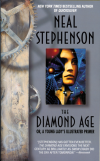Dune Messiah by Frank HerbertDune Messiah by Frank Herbert

Frank Herbert continues his epic saga with Dune Messiah. Paul “Muad’Dib” Atreides has been Emperor for 12 years following the ending of the first novel when he took over. He has become a god figure, messiah, to the Fremen, which have ravaged the galaxy spreading their religion to countless worlds. Paul has not been able to prevent the jihad, but has been able to control it in a way.
I never wanted to be a god, he thought. I wanted only to disappear like a jewel of trace dew caught in the morning. I wanted to escape the angles and the damned—alone … as though by an oversight.
Princess Irulan continues to compile her histories, denied the physical attention of Paul. Chani and Paul have tried to conceive and heir, but have yet to be successful. It turns out that Irulan has been slipping a contraceptive into Chani’s food, hoping that Paul will give up and produce an heir with herself. (more…)






